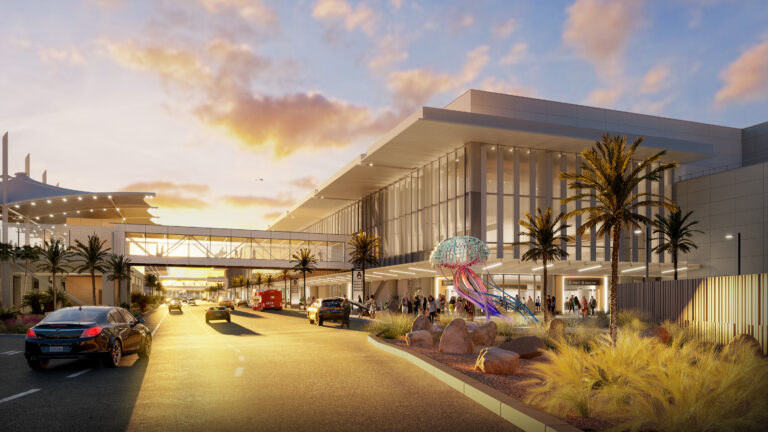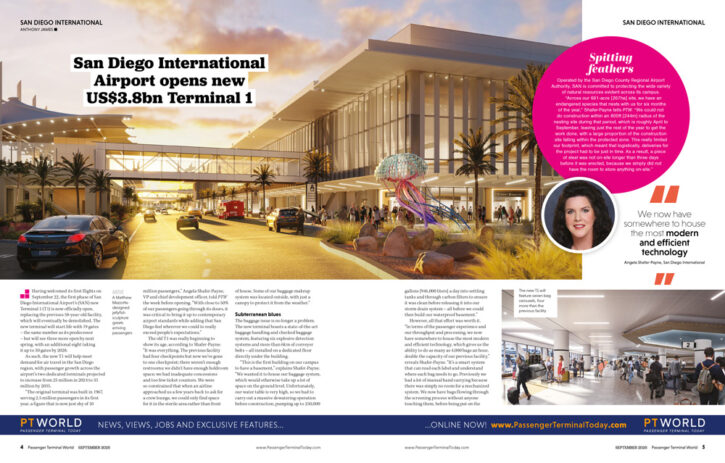PT World recently spoke to San Diego International’s VP and chief development officer, Angela Shafer-Payne, and VP and CFO, Scott Brickner, about the airport’s brand new US$3.8bn T1, in an exclusive feature first published in the September 2025 issue.
Having welcomed its first flights on September 22, the first phase of San Diego International Airport’s (SAN) new Terminal 1 (T1) is now officially open, replacing the previous 58-year-old facility, which will eventually be demolished. The new terminal will start life with 19 gates – the same number as its predecessor – but will see three more open by next spring, with an additional eight taking it up to 30 gates by 2028.
As such, the new T1 will help meet demand for air travel in the San Diego region, with passenger growth across the airport’s two dedicated terminals projected to increase from 25 million in 2024 to 35 million by 2035.
“The original terminal was built in 1967, serving 2.5 million passengers in its first year, a figure that is now just shy of 10 million passengers,” Angela Shafer-Payne, VP and chief development officer, told PTW the week before opening. “With close to 50% of our passengers going through its doors, it was critical to bring it up to contemporary airport standards while adding that San Diego feel wherever we could to really exceed people’s expectations.”
The old T1 was really beginning to show its age, according to Shafer-Payne: “It was everything. The previous facility had four checkpoints but now we’ve gone to one checkpoint; there weren’t enough restrooms; we didn’t have enough holdroom space; we had inadequate concessions and too few ticket counters. We were so constrained that when an airline approached us a few years back to ask for a crew lounge, we could only find space for it in the sterile area rather than front of house. Some of our baggage makeup system was located outside, with just a canopy to protect it from the weather.”
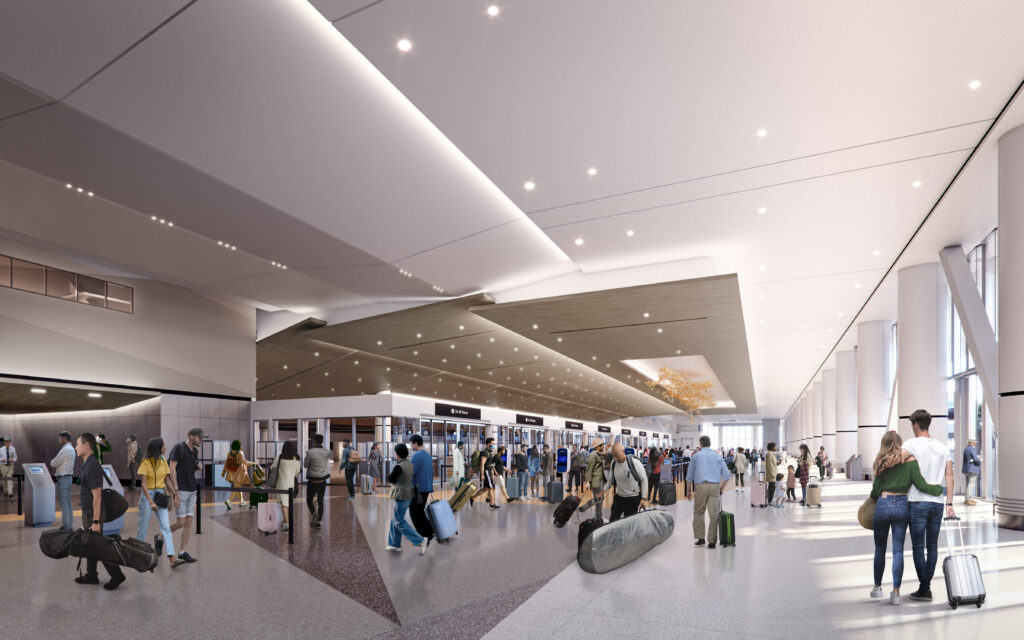
Baggage handling system
The baggage issue is no longer a problem. The new terminal boasts a state-of-the-art baggage handling and checked baggage system, featuring six explosive detection systems and more than 6km of conveyor belts – all installed on a dedicated floor directly under the building.
“This is the first building on our campus to have a basement,” explains Shafer-Payne. “We wanted it to house our baggage system, which would otherwise take up a lot of space on the ground level. Unfortunately, our water table is very high, so we had to carry out a massive dewatering operation before construction, pumping up to 250,000 gallons [946,000 liters] a day into settling tanks and through carbon filters to ensure it was clean before releasing it into our storm drain system – all before we could then build our waterproof basement.”
However, all that effort was worth it. “In terms of the passenger experience and our throughput and processing, we now have somewhere to house the most modern and efficient technology, which gives us the ability to do as many as 4,000 bags an hour, double the capacity of our previous facility,” reveals Shafer-Payne. “It’s a smart system that can read each label and understand where each bag needs to go. Previously we had a lot of manual hand carrying because there was simply no room for a mechanized system. We now have bags flowing through the screening process without anyone touching them, before being put on the correct outbound carousel. Testing during commissioning has seen the system operate at 99.7% accuracy, so we’re in good shape for opening.”
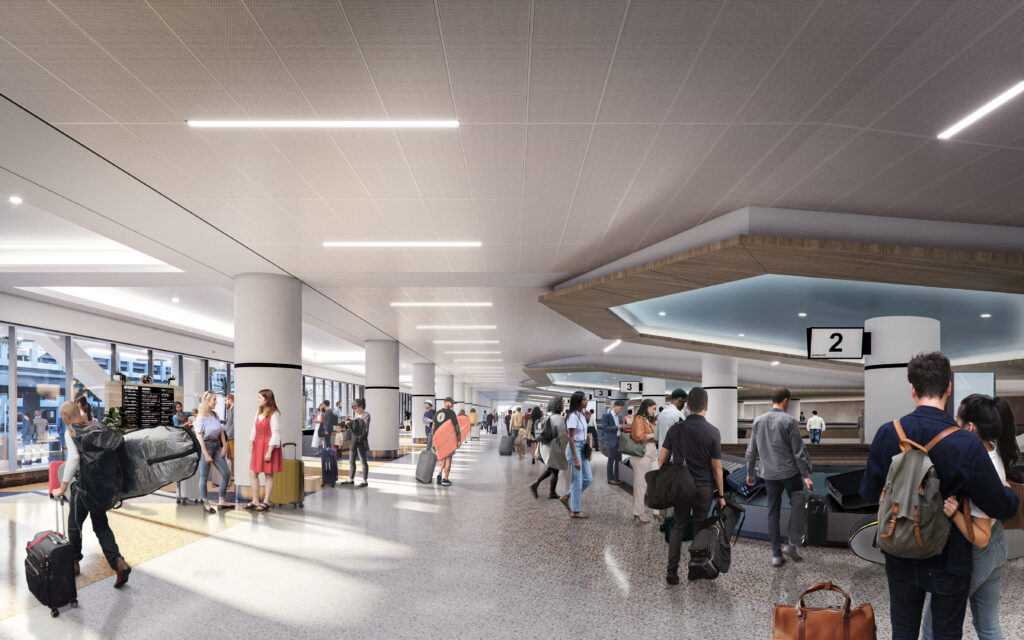
Financial planning
Covid threatened to derail the project’s finances at one point. However, as VP and CFO Scott Brickner explains, the airport and its airline partners made the right decision to press on. “Having spent a couple of years negotiating a 10-year management and lease agreement with the airlines on how to pay for the work back in 2019, all of a sudden Covid hits, and we’re down 97% on our traffic, with our non-aeronautical revenue pretty much non-existent,” he explains.
“We were faced with a decision: do we want to proceed or not? We decided to go ahead, which turned out to be the absolute right decision, as we all know what happened with inflation during that timeframe. Fortunately, a lot of the work was already contracted out. We did have to go back and ask the board for a budget increase in 2024 of just under 11%, but that compares favorably with projects at other airports, where they were looking at 30-40%. We also issued almost US$2bn of debt to fund the project in 2021 when interest rates were extremely low, improving our plan of finance by almost US$400m. From a financial perspective, we are doing better than what we had originally discussed with the airlines; and at this time, we expect that we’ll complete the project under the current budget.”
That budget now stands at US$3.8bn, with the project expected to create between 15,000 and 20,000 local jobs, significantly boosting the local economy.
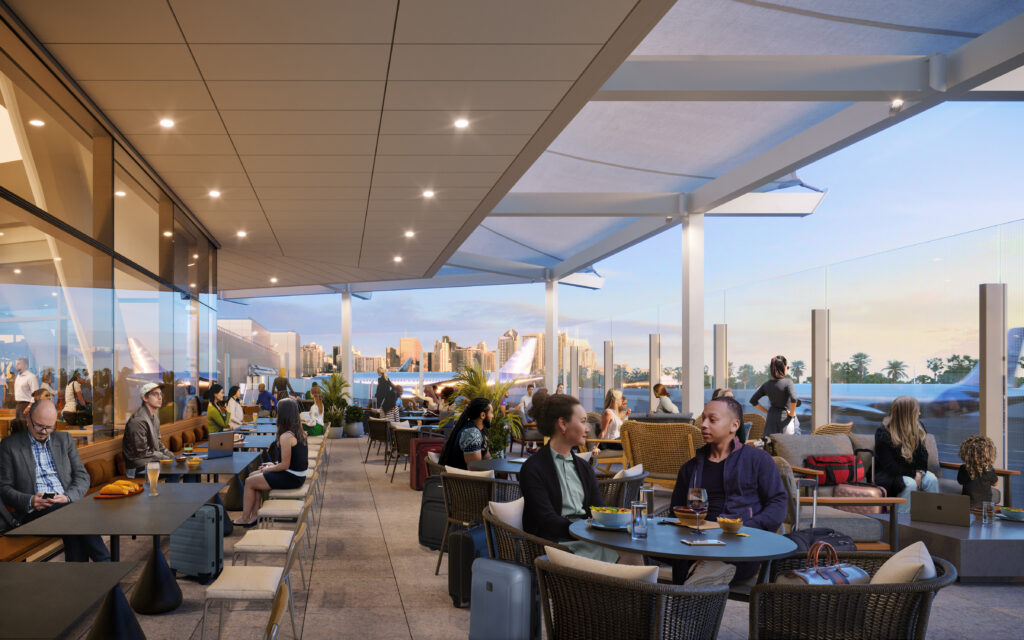
Improved security
All that investment will mean a much better experience for passengers, with Shafer-Payne zeroing in on security as just one example. “Over the last few decades, every airport has been caught flat-footed at certain times with different requirements that can pop up very quickly, where you must suddenly adjust your checkpoint,” she reports. “We now have our services in the ceiling so everything can be designed and installed with much greater flexibility. If we need to relocate cameras or other equipment, it’s now all plug-and-play from above. It all starts with the utility infrastructure, which gives us that ability to move things around very quickly.”
The checkpoint will feature 13 lanes, including a dedicated family lane and lanes for the popular TSA PreCheck and CLEAR programs, with room to add a further three lanes as required. “We can now offer individual lanes and try different things, all in one place, instead of having security split between four locations,” says Shafer-Payne.
Unfortunately, SAN won’t have the very latest scanning technology until a little further down the line: “We have looked at what is the state-of-the-art right now and how the checkpoint needs to be designed to accommodate it. However, here in the US, the TSA decides how they roll out new technology. Even though we have a new terminal, we did not get that new equipment. We’re on the list, and we’ll get it within the next couple of years, but the important thing is we’re ready for it.”
On-site staff also benefit from improved security arrangements. “We have upgraded our access control for the thousands of employees and tenant employees that work in the facility, which now incorporates dedicated employee checkpoints, having previously been something of an afterthought,” Shafer-Payne reports.
“We have now been able to think about where it makes most sense to have these checkpoints so once they’re through, staff can quickly disperse throughout the terminal.”
Concessions plan
Concessionaires at the new T1 will benefit from a 270% increase in floor space compared with the old terminal, with 4,552m2 now set aside for F&B and retail, compared with the previous 1,230m2. Overall, there will be 30 concessions spaces across the terminal, split between 21 F&B locations and nine retail stores, featuring brands such as Taco Stand, Chick-fil-A and Gaslamp MarketPlace. There’s even an outdoor patio and dining area, offering expansive views of San Diego’s harbor.
Energy efficiency
The new T1 will be powered by 100% carbon-free electricity, with charging for more than 250 electric vehicles, an additional 250 EV-ready spaces and an all-electric shuttle service. There will also be more than 300 bicycle parking spaces. Airfield improvements will help reduce emissions and aircraft delays, while a climate-resilient design will address future sea-level rises. An underground fuel-delivery system eliminates the need for aircraft fueling trucks, and an expanded stormwater capture and reuse system includes a 3,785,500-liter underground cistern.
The airport will also generate its own green energy while cutting demand for power. “Once this project is complete, the photovoltaic panels that we’re installing will deliver 9.5MW of solar, which is about half of our demand for our total campus,” says Shafer-Payne. “We’ve installed escalators that shut off until somebody walks up to them; and we bring in as much natural light as possible to help reduce reliance on light fixtures during the day. We’ve got pre-conditioned air units at all our gates, so we can turn off the aircraft auxiliary power units. We’re even grabbing the condensate from those units, because the building is double plumbed, and then putting it back into the building to help flush the toilets. Sometimes we even give it to a local brewery to produce an aviation-themed micro brew!”
Despite adding to the cost, Brickner says the investment in sustainability features is like an insurance policy: “It’s risk management – we built the new terminal higher so if there is a once-in-a-hundred-year major flood event, it won’t be underwater and won’t have to then be rebuilt at huge cost. It will also be able to accommodate what the community needs in the event of such a major disaster.”
Normally, San Diego gets more than its fair share of sunshine – and Shafer-Payne says the terminal’s new design will embrace all that natural light, with its glass façade providing plenty of views of the surrounding landscape. “We’re using curved glass that incorporates a fret pattern designed by James Carpenter, a renowned glass artist, to help reduce glare and heat coming into the building. It’s both beautiful and functional.”
Asked to name a key design feature, she opts for the statement sculpture that adorns the entrance of the new terminal. “We have a piece of artwork that showcases a jellyfish native to San Diego,” she says. “The artist has popped it up a shade or two so we now have a 20ft [6m]-tall, bright pink jellyfish right out in front that I suspect will provide that Instagram moment. I should say we’re also proud of our bathrooms, which are very spacious and have some nice design touches – I know on a few tours, I’ve lost people for more than 10 minutes in them!”
This article was first published in the September 2025 issue of PT World magazine. You can read the article in its original format, here; and you can also find our archive of previous issues, here.

